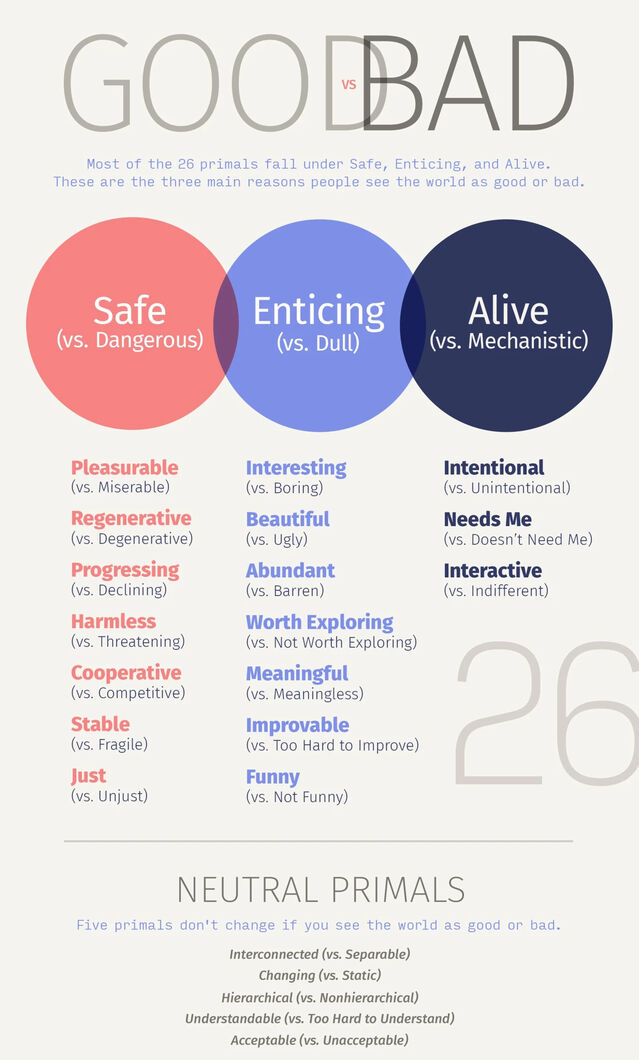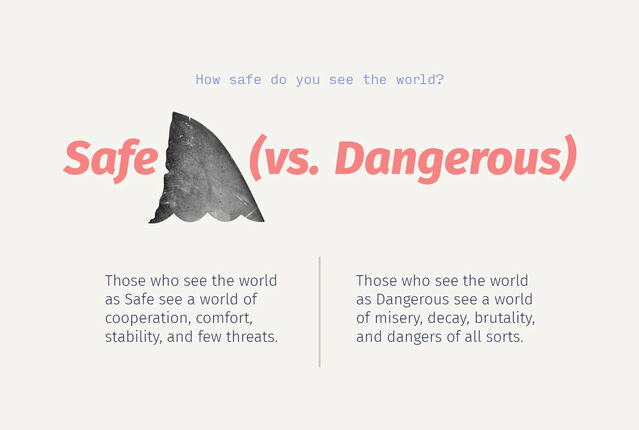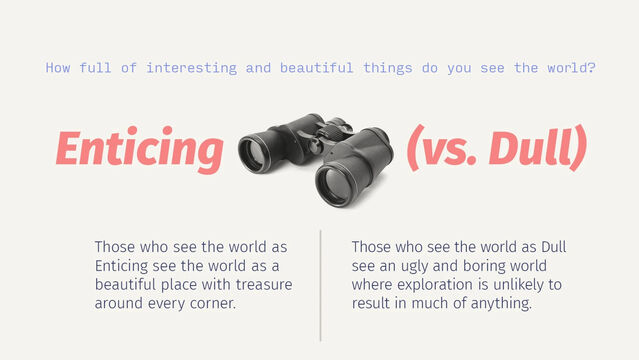Personality
What Are Your 3 Deepest Beliefs About the World?
Introducing emerging research on primal world beliefs
Posted March 28, 2022 Reviewed by Tyler Woods
Key points
- Major scientific effort finds that people hold three main beliefs about the world.
- These three beliefs concern how Safe, Enticing, and Alive the world is.
- They are strongly correlated to our day-to-day behavior and happiness.
Your beliefs about a place strongly impact your behavior while in that place. For example, if you see a place as a battleground, you’re jumpy and ready to fight. If you see a place as a playground, you play. You feel good. You make friends.
What happens if you see the whole world as a battleground? Just like beliefs about local contexts, world beliefs could impact us, but constantly. If that's true, then depression, success, optimism, extraversion—honestly, most parts of psychology people care about—could be affected.

What Are Our Major World Beliefs?
In 2013, I learned that psychologists had never attempted to empirically derive (I'll explain what that means in a second) humanity's most basic beliefs about the general character of the world. So I left my profession and became a researcher.
We came up with what we called "primal world beliefs," or primals. For five years, I led an effort to discover the major primal world beliefs most humans hold. It involved 70 researchers, including some of the world’s best, like Dr. Martin Seligman and Dr. Crystal Park. We published everything in 2019 in the most respected journal for this sort of thing.
Fancy Stats Wizardry
For non-nerds, “empirically derived dimensionality” means results are based on data and not theories researchers dream up. For example, scientists know personality varies on five dimensions (extraversion, conscientiousness, etc.) not because someone came up with five ideas, but because, when nerds like me ask hundreds of questions about personality, there are usually five patterns in the data. Statistics can even tell us which question best captures the meaning of each pattern, so we know both how many patterns there are and what they mean.
For the Wizardry to Work, You Need an Exhaustive Set of Questions
To create an exhaustive (or as close as we could) set of questions about primal world beliefs, we went big, pursuing 10 projects. We analyzed more than 80,000 tweets beginning with phrases like, “the world is…” drawn from a randomly selected database of 2.2 billion tweets. 22 researchers combed through the 358 most influential texts in world history—novels, speeches, treatises, films, and sacred texts—finding and sorting more than 1,700 claims about the world.
We analyzed the 840 most-used adjectives in modern American English, drawn from a representative 190-million word database. This meant we explored not just the world beliefs people said but the world beliefs that are possible. We ran 12 focus groups in all four major world religions (Islam, Christianity, Hinduism, Buddhism). Five scholars gathered relevant work in six disciplines—psychology, philosophy, art history, comparative religion, anthropology, and political science—compiling a 415-page tome.
Ten top nerds in America met for three days, including famous evolutionary biologist Dr. David Sloan Wilson and Stanford belief Psychologist Dr. Carol Dweck. We had a retreat of top Chinese experts at Tsinghua University in China... you get the point. We tried to cast a wide net.
The 10 projects took a year and a half to complete. At first, we were discovering new candidate primals almost weekly, with many “Wow! How did we miss that?” moments. But nine months in, that stopped. We reached what researchers call “saturation,” indicating few other candidate primals were likely out there.
So, we took these inputs, identified a few hundred questions, gave them to a few thousand people, did the stats wizardry, did a bunch of follow-up studies to make sure what we found was real, and we've now found the same results in bigger and bigger samples.
We Found More Primals Than Researchers Knew
All 26 of these dimensions are:
- Very stable across time, as stable as personality traits like extraversion
- Hidden; you can’t tell someone’s primals by looking at them or knowing their life history
- Highly correlated to how we live our lives and our mental health

But all primals are not equally important. Most collapse for statistical and conceptual reasons into three big ones:
1. Safe World Belief
Those low on Safe world belief see the world as dangerous. These people don’t necessarily feel more scared or threatened in response to dangers, they are just of the honest opinion that there’s a lot more danger out there than the rest of us suspect—from germs to sharks to terrorism to getting insulted. So being alert seems responsible, and relaxing isn't a great idea. Better safe than sorry.
Those high on Safe world belief see really dangerous threats as few and far between. Thus, they feel that constant vigilance is neurotic, risk is not that risky, and, in general, people should calm down.

Safe world belief is very strongly correlated to things like greater trust, higher agreeableness, and lower depression. Interestingly, men and women on average see the world as equally Safe. In fact, Safe is correlated surprisingly little to actual experiences of danger. This suggests that Safe world belief may be more like a lens used to interpret our life than a mirror reflecting what our life has been.
2. Enticing World Belief
Those low on Enticing world belief see the world as dull. In their view, truly beautiful and fascinating things are rare. Therefore, treasure-hunting, social exploration, risk-taking, and so forth, are only appropriate when it’s a sure bet.
Those high on Enticing world belief are of the opinion that treasure is around every corner, in every person, under every rock, and that beauty permeates everything. Therefore, exploration and appreciation are not naïve. It's simply the rational way to live.

Enticing is very strongly correlated to things like curiosity, gratitude, and happiness. Like Safe, Enticing is uncorrelated to wealth or privilege; anyone can see the world as Enticing.
3. Alive World Belief
Those low on Alive world belief see the world as a machine with no awareness or intentions. Since the universe never sends messages, it makes no sense to try and listen for any. Just as machine parts are interchangeable, so too are people: the world doesn’t need you for anything special.
Those high on Alive world belief think everything happens for a purpose and listen constantly for those purposes. To them, life is a relationship with an active universe that animates events, communicates, and has a role for each of us to play.

Alive is strongly correlated to things like spirituality and having purpose in life. Though religious people tend to see the world as Alive, plenty of non-religious people do, too.
Which Primal World Beliefs Are True?
Mine, of course.
Just kidding. As an empirical researcher, my job is not to tell you the truth of ultimate reality but to study the impact of these beliefs, to learn where they come from, and to tell you what I find. You can draw your own conclusions about the universe.
Lots of Primals Research is Coming
Right now, primals research is in its infancy. We basically have no idea where primals come from and, though they could play a major role in shaping our lives, we aren't yet sure of that either. But that's changing.
Last year we started the UPenn Primals Project. Now, dozens of research efforts have emerged worldwide, and the primals survey is being translated into 20 languages. We've begun work studying how backgrounds (seemingly don't) influence primals, the impact of extreme life events on primals (e.g., trauma, incarceration, getting cancer), if new interventions can influence primals to improve wellbeing, and how primals influence politics. We are collaborating with researchers on how psilocybin impacts primals, and even robotics experts on the effects of giving primals to robots to simulate human personality. Other projects include looking at the primals of terrorists, and how primals affect love and marriage, among several others.
So we are going to discover a ton about primals in the next few years. My plan is to summarize major findings for Psychology Today as it all emerges. My first piece describes an early study on the primal world beliefs that parents want to teach their kids (and maybe shouldn't).
Scientists have identified what our primal world beliefs are but not where they come from or how they impact us. The good news: some of the world's best scientists are now on it. The bad news: we have to wait.
References
I study primals because (I'm a nerd and I like it, sure, but also) I think it might help people. If you want to help, too, here's how:
Discover your own primals here by taking our free validated survey. You'll help ongoing research.
Send me your insights about how your primals have changed over time or impacted your life (tweet or direct message me at @jerclifton). I get many of my best research ideas this way.
Tell people about primals. There are dozens of obvious, important, and urgent questions that nobody is studying yet, just because we lack nerd capacity. For example, can a therapist help a depressed patient by altering the patient’s primal world beliefs? Can we lower suicide risk by increasing the belief the world is a pleasure to live in? How do you deal with a boss who sees the world as really dangerous? We need more research!
Clifton, J. D. W., Baker, J. D., Park, C. L., Yaden, D. B., Clifton, A. B. W., Terni, P., Miller, J. L., Zeng, G., Giorgi, S., Schwartz, H. A., & Seligman, M. E. P. (2019). Primal world beliefs. Psychological Assessment, 31(1), 82–99. https://doi.org/10.1037/pas0000639
Clifton, J. D. W. (2020). Testing if primal world beliefs reflect experiences—At least some experiences identified ad hoc. Frontiers in Psychology, 11, 1145. https://doi.org/10.3389/fpsyg.2020.01145
Clifton, J. D. W., & Meindl, P. (2021). Parents think -incorrectly- that teaching their children that the world is a bad place is likely best for them. Journal of Positive Psychology, 17(2), 182-197. https://doi.org/10.1080/17439760.2021.2016907
Koltko-Rivera, M. E. (2004). The psychology of worldviews. Review of general psychology, 8(1), 3-58. https://doi.org/10.1037/1089-2680.8.1.3




